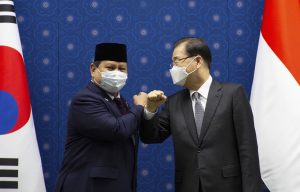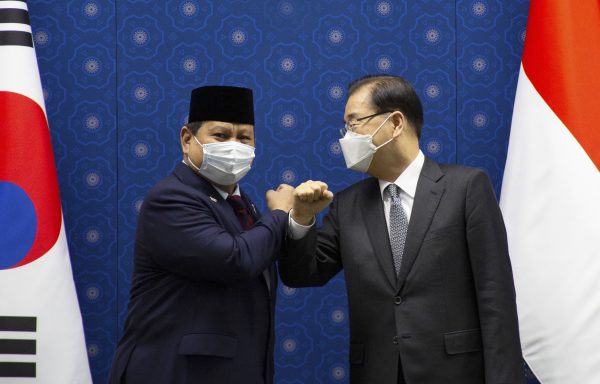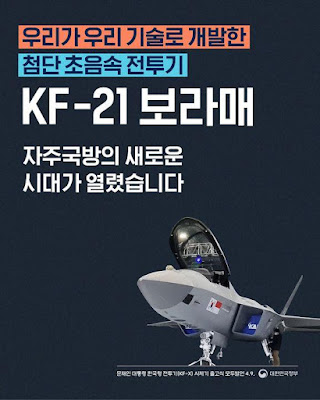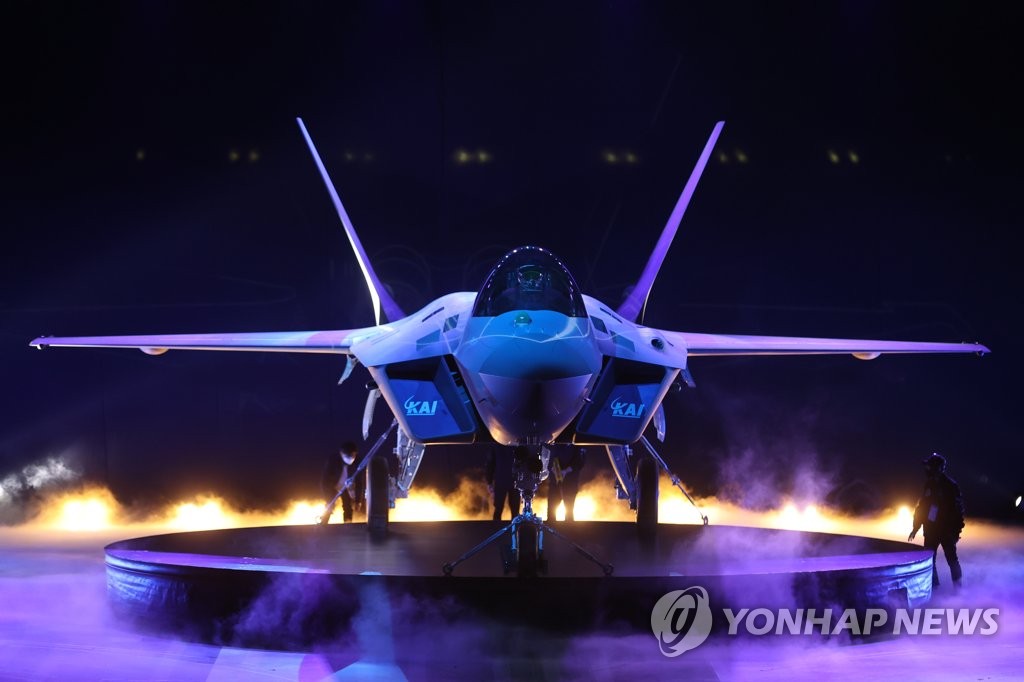Anti dronenya beli barang Yahudi, drone tempurnya pake barang Cino
You are using an out of date browser. It may not display this or other websites correctly.
You should upgrade or use an alternative browser.
You should upgrade or use an alternative browser.
Indonesia Indonesian Air Force, Tentara Nasional Indonesia-Angkatan Udara (TNI-AU)
- Thread starter TR_123456
- Start date
Mungkin untuk yg satu ini menganut pakem "asal jangan amerika"Anti dronenya beli barang Yahudi, drone tempurnya pake barang Cino
More like we don't get permission.Mungkin untuk yg satu ini menganut pakem "asal jangan amerika"

Even Saudi doesn't get it.
Var Dracon
Contributor
Yes, for some time US restricted (or even banned) the sale of Predator drones and any drones with capability above it. Only recently they gave it permission.More like we don't get permission.
Even Saudi doesn't get it.
reashot_xigwin
Active member
The Strategic Impact of Indonesian KF-21s
Using the phrase “arms race” is attention grabbing, but a more discerning assessment is necessary when it comes to weapons acquisitions.
By Liang Tuang Nah
April 16, 2021

Indonesian Defense Minister Prabowo Subianto, left, bumps elbows with South Korean Foreign Minister Chung Eui-yong prior to their meeting at the foreign ministry in Seoul Friday, April 9, 2021.
Credit: Jeon Heon-kyun/Pool Photo via AP
On April 9, a prototype of an advanced multi-role combat jet, the KF-21 Boramae (“young hawk” in Korean) was introduced by South Korea with President Moon Jae-in and Indonesian Defense Minister Prabowo Subianto in attendance. While it is clear that Seoul’s decision to develop an indigenous fighter jet is driven by desires for defense industry self-sufficiency, along with national pride, Prabowo’s presence signifies Jakarta’s commitment to acquiring the KF-21, thereby further diversifying Indonesia’s air force fleet to limit reliance on any one foreign supplier. The bulk of Indonesian warplanes currently come from the United States and Russia.
Will the Boramae Impact the Regional Strategic Status Quo?
Based on publicly sourced research, the KF-21 is touted to be superior to contemporary non-stealthy advanced fighters like the U.S. F-16 or the French Dassault Rafale. The Boramae’s selling points include greater operational range, more advanced avionics and electronic warfare capabilities, along with a Korean-made active electronically scanned array (AESA) radar, which has improved target detection and tracking capability versus earlier radar technologies, leading to more effective weapons delivery. Moreover, the KF-21 is designed to possess baseline radar evading stealth capabilities, which are inferior to full-fledged stealth fighters like the F-35, but give it an edge over potential non-stealthy adversaries.
When coupled with a weapons package comprising advanced infrared and radar guided air-to-air missiles for shooting down enemy aircraft, and air-to-ground munitions including accurate missiles and guided bombs, it can be seen why casual observers might infer that Indonesia’s pending order of 50 KF-21s might impact the future balance of military air power in Southeast Asia.
Important Context for the KF-21 Acquisition
Enjoying this article? Click here to subscribe for full access. Just $5 a month.
Using the phrase “arms race” is attention grabbing, potentially leading to greater media circulation and corresponding advertising revenue. However, it pays to be more discerning and dispassionate when analyzing national weapons acquisition. Regarding future Indonesian KF-21s, it can be argued that Jakarta has two major considerations: expansive territorial defense and aircraft fleet obsolescence, neither of which should be alarming or sensational.
Concerning Indonesian airspace, the TNI-AU (Indonesian Air Force) has 1,904,569 square km of land to cover and a far larger sovereign airspace over Indonesian soil and internal waters, which it needs to patrol. Additionally, operational and security considerations may, from time to time, necessitate missions over Indonesia’s expansive maritime exclusive economic zone (EEZ). All of this requires a sufficiently large air fleet which the TNI-AU arguably does not possess, since it currently has only 101 armed aircraft and six maritime patrol planes to police or guard its extensive airspace responsibilities. Furthermore, not all of these airframes are always available or airworthy since a proportion will at any time be undergoing maintenance or grounded awaiting spare parts delivery. Seen in this light, the TNI-AU’s acquisition of 50 Boramae fighters in the next few years does not look like an unreasonable proposition for national security maintenance.
Turning to the issue of air fleet obsolescence, it should be mentioned that the additional 50 KF-21s are probably meant to replace some or all of Indonesia’s out-of-date warplanes. A quick look at the TNI-AU’s fighter inventory reveals a few models that are growing long in the tooth, and would be obsolete in the next decade. Examples include the Russian made Su-27, which was acquired in 2002 and 2006 (five aircraft in total), U.S. made F-16As and F-16Bs ordered in 1989 (10 still in service), and British made BAE Hawk Mk 109 and Mk 209 jets delivered by 1997 (total of 30 in service). If all these jets were retired due to uneconomical maintenance costs or aging unsafe airframes, the replacement Boramae fighters would only bring the TNI-AU’s combat fleet to 106, an increase of only five aircraft, which hardly deserves media attention.Operational Issues Relevant to TNI-AU Modernization
Lastly, there are intangible and tangible issues related to an air force’s operational readiness and effectiveness, which most journalists never consider. Intangible factors like doctrinal effectiveness and pilot quality are hard to measure while tangible aspects such as availability of spare parts and sufficient stocks of compatible munitions are seldom investigated by the press.
With reference to doctrine, these refer to guidelines on how best to employ military force to achieve set objectives, while pilot readiness is often judged based on a few factors such as the number of annual flying hours, performance during international military exercises, and combat experience of the air force in question. Inasmuch as military doctrine is often classified, there are no means of examining authenticated TNI-AU doctrine; hence it is prudent to withhold comment about the efficacy of Indonesian air force tactics and strategy.
As for the aviators, competence should not be underestimated but one should note that the real-world operational experience of the TNI-AU only covers counterinsurgency missions against domestic rebels, not operations against the combat forces of other states. Also, it is not known whether Indonesian pilots receive the same number of flying hours as NATO air forces (100-150 hours/year), but it must be noted that concrete issues like spare parts availability can affect airworthiness to such an extent that fleets can be grounded, forcing pilots to resort to ground based simulators. For example, in 2005 logistical deprivation from a U.S. embargo resulted in minimal to nil operational availability for U.S.-made Indonesian assets like F-16s and A-4s.
Finally, the impactfulness of an air force rests to a substantial extent on its stocks of missiles and bombs delivered by its aircraft. Putting aside the quality of such armaments, open source research reveals no information about the amount of airborne weapons maintained by the TNI-AU. But it is notable that they procure both Russian and U.S. munitions, leading to greater complexity and strain on the logistical system, which might well hamper operational availability and the air force’s potential. Since the KF-21 is slated to employ both U.S. and European missiles, the eventual incorporation of an Indonesian Boramae fleet could overstretch the TNI-AU’s supply network.
Rational Analysis Versus Hype
If anything, the KF-21 sale is an exercise in military, strategic, and industrial diplomacy by the Moon administration in support of Seoul’s ASEAN-centric “New Southern Policy.” From Jakarta’s perspective, the Boramae acquisition is probably intended to effect timely defense modernization for the TNI-AU while preserving status quo national interests. As such, overeager commentators should be encouraged to exercise restraint, especially when they understand little about the national imperatives of regional middle powers, and limitations or inner workings of their militaries.

The Strategic Impact of Indonesian KF-21s
Using the phrase “arms race” is attention grabbing, but a more discerning assessment is necessary when it comes to weapons acquisitions.
thediplomat.com
Why?and rafale hype is over
Are you talking about IFX's engine options?Just wait what engine that we will use and what kind of term to have it. Buying something for something
US made, France made, or europe consortium
Just stay with more powerful F414
Just waitWhy?
Are you talking about IFX's engine options?
Just stay with more powerful F414
Indonesia Asks for S. Korea's Support to Cover Tech Gap in Joint Fighter Project
28 April 2021

KF-21 Boramae fighter (image : m.korea)
SEOUL (Yonhap) -- Indonesia has asked South Korea to help its engineers involved in a joint fighter jet development project catch up with the technological progress made while they were away back home over coronavirus concerns, the defense ministry said Wednesday.
Indonesia is a partner for South Korea's 8.8 trillion won (US$7.9 billion) project to develop its first homegrown supersonic combat plane, though Jakarta has stopped making payments for the 20 percent of the total development cost it had promised to shoulder.
Indonesian engineers had been participating in the development in South Korea, but they returned home in March last year amid the coronavirus pandemic. South Korean engineers continued with the development and unveiled the jet's first prototype earlier this month.
The ministry said Indonesia reaffirmed its commitment to the project during its Defense Minister Prabowo Subianto's visit to South Korea to attend the rollout ceremony, after its failure to make payments gave rise to speculation that the country could quit the program.
"Indonesia welcomed proposals made by South Korea to boost the two countries' defense cooperation and expressed hope for South Korea's support to help Indonesian officials catch up with the technology gap in the KF-21/IF-X joint development project," the ministry said a report to the parliament.
Possible cooperation includes the provision of unused military supplies to Indonesia, the ministry said.
(Yonhap)
??
is it really good to get that EDA ? i mean the public just currently all over the nanggala incident , i have fear they would have a negative point of view in "Used/Second-Hand" alutsista .Indonesia Asks for S. Korea's Support to Cover Tech Gap in Joint Fighter Project
28 April 2021

KF-21 Boramae fighter (image : m.korea)
SEOUL (Yonhap) -- Indonesia has asked South Korea to help its engineers involved in a joint fighter jet development project catch up with the technological progress made while they were away back home over coronavirus concerns, the defense ministry said Wednesday.
Indonesia is a partner for South Korea's 8.8 trillion won (US$7.9 billion) project to develop its first homegrown supersonic combat plane, though Jakarta has stopped making payments for the 20 percent of the total development cost it had promised to shoulder.
Indonesian engineers had been participating in the development in South Korea, but they returned home in March last year amid the coronavirus pandemic. South Korean engineers continued with the development and unveiled the jet's first prototype earlier this month.
The ministry said Indonesia reaffirmed its commitment to the project during its Defense Minister Prabowo Subianto's visit to South Korea to attend the rollout ceremony, after its failure to make payments gave rise to speculation that the country could quit the program.
"Indonesia welcomed proposals made by South Korea to boost the two countries' defense cooperation and expressed hope for South Korea's support to help Indonesian officials catch up with the technology gap in the KF-21/IF-X joint development project," the ministry said a report to the parliament.
Possible cooperation includes the provision of unused military supplies to Indonesia, the ministry said.
(Yonhap)
??
is it really good to get that EDA ? i mean the public just currently all over the nanggala incident , i have fear they would have a negative point of view in "Used/Second-Hand" alutsista .
I believe it is ships, not really as critical as like submarines, and maybe younger airframe of transport plane to replace current older ones as stop gap measure. I believe public will understand if they are given the explanation over the reasons of that planning.
"President Joko Widodo himself agreed to the continuation of the KF-21/IF-X business, and the defense minister has also expressed willingness to do his best for the success of the project," the ministry said.
The joint work is expected get back on track in months, officials said, with the two sides pushing to hold the next round of negotiations on sharing the development cost in the first half.
The two countries launched negotiations on the fighter jet project in 2018 after Indonesian President Joko Widodo sought to adjust his country's burden, citing financial difficulties. They last held negotiations in September 2020.
The arms procurement agency said the KF-21 will undergo various ground tests starting next month.
The first flight test is scheduled for 2022, with the entire development set to be completed by 2026

 en.yna.co.kr
en.yna.co.kr
The joint work is expected get back on track in months, officials said, with the two sides pushing to hold the next round of negotiations on sharing the development cost in the first half.
The two countries launched negotiations on the fighter jet project in 2018 after Indonesian President Joko Widodo sought to adjust his country's burden, citing financial difficulties. They last held negotiations in September 2020.
The arms procurement agency said the KF-21 will undergo various ground tests starting next month.
The first flight test is scheduled for 2022, with the entire development set to be completed by 2026

Indonesia asks for S. Korea's support to cover tech gap in joint fighter project | Yonhap News Agency
By Choi Soo-hyang SEOUL, April 28 (Yonhap) -- Indonesia has asked South Korea to help it...
@Indos
Boramae is an 1.8 match Fighter so it definitely not a capable energy fighter.
Its main "weapon" in a dogfight is advance flight control that capable of high angle of attack (AoT) just like any other Fighter with "nanggung" speed (SHornet, rafale, lightning 2, etc)
How is korean capability to devote advance flight control system?
Is it already on this level?
Boramae is an 1.8 match Fighter so it definitely not a capable energy fighter.
Its main "weapon" in a dogfight is advance flight control that capable of high angle of attack (AoT) just like any other Fighter with "nanggung" speed (SHornet, rafale, lightning 2, etc)
How is korean capability to devote advance flight control system?
Is it already on this level?
@Indos
Boramae is an 1.8 match Fighter so it definitely not a capable energy fighter.
Its main "weapon" in a dogfight is advance flight control that capable of high angle of attack (AoT) just like any other Fighter with "nanggung" speed (SHornet, rafale, lightning 2, etc)
How is korean capability to devote advance flight control system?
Is it already on this level?
I dont know bro
Any way about the speed during the launch of KF 21, they said the speed is 2 Mach.
This I add more information from Korean member in PDF :
Last edited:
Pusat Kelaikan Kemhan RI
 www.kemhan.go.id
www.kemhan.go.id
Pusat Kelaikan Kemhan RI
 www.kemhan.go.id
www.kemhan.go.id
Last edited:
Dogfighting is dead in today's world of HMCS, and HOBS WVRAAMs.I dont know bro
Any way about the speed during the launch of KF 21, they said the speed is 2 Mach.
This I add more information from Korean member in PDF :
View attachment 19289
Dogfighting is dead in today's world of HMCS, and HOBS WVRAAMs.
You dont consider ECM can avoid BVR missile ?
LIG Nex1 delivers EW self-protection system prototype for KF-X fighter aircraft
South Korean defence company LIG Nex1 has developed an electronic warfare (EW) self-protection system for integration with the Korean Fighter eXperimental (KF-X) fighter...
While classic dogfighting won't happen as often as it did in WW2, Korean and Vietnam war, but to declare its already dead is premature. Dogfight is dead when one country which posses all the technological bell and whistles (like BVRAAM supported by AEW&C, Electronic Warfare aircrafts and so on) go all out against other country which doesn't. In this case, the former can always detect its adversary aircrafts and destroy them from beyond visual range without breaking any sweat.Dogfighting is dead in today's world of HMCS, and HOBS WVRAAMs.
Once the technological gap narrowed, i.e. when the same country has to fight against similarly equipped force, their opponents also have the capability to detect missile launch from afar - thus alerting their friends to take evasive actions. It'll get more difficult if the opposing forces also have advanced ECM and ECCM or - probably - some kind of active protection system installed in their planes, not to mention that there's also a possibility that in a stealth vs stealth scenario, air combat between two stealth planes can quickly changes from BVR to WVR. In this case, if both fighters have already expended their missiles, there will be no other choice but to duke it out in close range with guns.
Yes, the possibility of this scenario to happen is very small. But it's still one of many things that can happen which will prove opinions like "guns are obsolete" during combat are wrong.
WVR missiles can hit from 20+km away now so even if that happened you would be hit by an AIM-9X.You dont consider ECM can avoid BVR missile ?
View attachment 19299
LIG Nex1 delivers EW self-protection system prototype for KF-X fighter aircraft
South Korean defence company LIG Nex1 has developed an electronic warfare (EW) self-protection system for integration with the Korean Fighter eXperimental (KF-X) fighter...www.janes.com
Modern day dogfights will almost never happen during conflicts.
Last edited:




